Click on images to enlarge
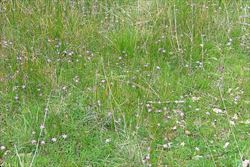
infestation of Romulea rosea var. australis growing in natural vegetation (Photo: Sheldon Navie)

infestation of Romulea rosea var. australis growing in a mown area (Photo: Sheldon Navie)

habit of Romulea rosea var. australis (Photo: Sheldon Navie)
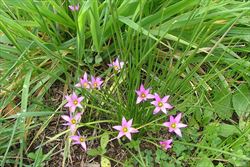
habit of Romulea rosea var. australis (Photo: Sheldon Navie)

leaves and flowering stems of Romulea rosea var. australis (Photo: Sheldon Navie)
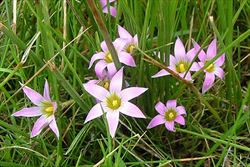
the pink flowers of Romulea rosea var. australis, which have yellow centres bordered with white (Photo: Sheldon Navie)
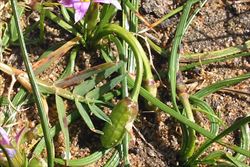
immature fruit of Romulea rosea var. australis (Photo: Sheldon Navie)

habit of Romulea rosea var. communis (Photo: Sheldon Navie)

close-up of the magenta flower of Romulea rosea var. communis, which has a yellow centre bordered with dark purple (Photo: Sheldon Navie)
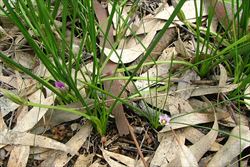
comparison of common onion grass (Romulea rosea var. australis), on the left, and small-flowered onion grass (Romulea minutiflora), on the right (Photo: Sheldon Navie)
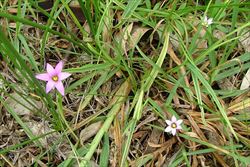
comparison of the flowers of common onion grass (Romulea rosea var. australis), on the left, and small-flowered onion grass (Romulea minutiflora), on the right (Photo: Sheldon Navie)
Scientific Name
Romulea rosea (L.) Eckl.
Three varieties of this species are present in Australia:
Romulea rosea (L.) Eckl. var. australis (Ewart) M.P. de VosRomulea rosea (L.) Eckl. var. communis M.P. de VosRomulea rosea (L.) Eckl. var. reflexa (Eckl.) Beg.
Synonyms
Romulea bulbocodium (L.) Sebast. & Mauri (misapplied)Romulea bulbocodium (L.) Sebast. & Mauri var. cruciata (Ker Gawl.) EwartRomulea cruciata (Ker Gawl.) Eckl. var. australis EwartRomulea longifolia (Salisb.) BakerRomulea parviflora Eckl.Trichonema cruciatum Ker Gawl.Trichonema longifolium Salisb.
Family
Iridaceae
Common Names
australis oniongrass, common onion grass, common onion-grass, common romulea, Guildford grass, onion grass, onion weed, pink romulea, rosy sand crocus, rosy sand-crocus, rosy sandcrocus
Origin
Native to southern Africa (i.e. southern Cape Province in South Africa).
Cultivation
Common onion grass (Romulea rosea) was deliberately introduced and cultivated as a garden plant (i.e. ornamental).
Naturalised Distribution
Romulea rosea var. australis is the most widespread subspecies in Australia, and is widely naturalised in the southern and eastern parts of the country. It is common in eastern and southern New South Wales, in the ACT, in Victoria and Tasmania, in south-eastern South Australia and in south-western Western Australia. It is also present in other parts of South Australia, naturalised on Lord Howe Island and Norfolk Island, and sparingly naturalised in south-eastern Queensland.
Romulea rosea var. communis is widely naturalised in south-western Western Australia, but is not known from other parts of the country.
Romulea rosea var. reflexa has been recorded as locally naturalised in Victoria.
Common onion grass (Romulea rosea) is also naturalised overseas in Europe, south-western USA (i.e. California) and New Zealand.
Habitat
A very common weed of lawns, footpaths, parks, roadsides, gardens, pastures, crops, disturbed sites, waste areas, grasslands, open woodlands and wetlands in temperate regions. It is occasionally also found growing in semi-arid and sub-tropical environments.
Habit
A small herbaceous plant growing each year from a rounded underground 'bulb' (i.e. globose corm).
Distinguishing Features
- a small herbaceous plant growing each year from a rounded underground 'bulb'.
- its grass-like leaves (8-65 cm long and only 1-2.5 mm wide) are clustered together at the base of the plant.
- these very narrow leaves are hairless, somewhat flattened, and have a groove running lengthwise.
- its pale pink to bright pink flowers (15-30 mm long) are borne singly on stems 3-12 cm long and have a yellow centre.
- its fruit is a small cylindrical capsule (6-13 mm long and 3-7 mm wide) that splits open when mature.
Stems and Leaves
This species does not produce any aboveground stems, except for its hairless (i.e. glabrous) flowering stems.
The grass-like leaves (8-65 cm long and only 1-2.5 mm wide) are clustered together at the base of the plant. They are long and narrow (i.e. linear), somewhat flattened, and have a groove running lengthwise. These shiny leaves have entire margins, pointed tips (i.e. acute or acuminate apices) and are hairless (i.e. glabrous).
Flowers and Fruit
The upright (i.e. erect) flowering stems (i.e. scapes) are 3-12 cm long and each has two narrowly-triangular bracts that subtend a single flower. The outer bract is slightly larger (10-15 mm long) than the inner bract. The flowers are pale pink to bright pink, often with purplish markings, and have a yellow centre. These flowers (15-30 mm long) have six 'petals' (i.e. tepals or perianth segments) that are fused together at the base into a short tube (i.e. perianth tube) 2-4 mm long. The 'petals' are oval (i.e. elliptic) in shape (10-18 mm long and 3-4 mm wide) with pointed tips (i.e. acute apices). Flowers also have three bright yellow stamens and an ovary topped with a three-branched style (7-9 mm long), with each style branch being divided in two again just before its tip. Flowering occurs mostly during spring (i.e. from August to November).
The fruit is a small cylindrical capsule (6-13 mm long and 3-7 mm wide) that splits open when mature. These capsules contain numerous small reddish-brown seeds that are about 1 mm across.
Reproduction and Dispersal
This species reproduces by seed and vegetatively via is 'bulbs' (i.e. corms).
The seeds are probably dispersed by water and when infested areas are mown or slashed, while the 'bulbs' can be spread in dumping garden waste and contaminated soil.
Environmental Impact
Common onion grass (Romulea rosea) is a significant environmental weed in Victoria and Western Australia, and an environmental weed in South Australia, the ACT and New South Wales.
Legislation
This species is declared under legislation in the following states and territories:
- New South Wales: Class 5 - a restricted weed which must not be sold, bought or knowingly distributed (throughout the entire state). This declaration applies to all onion grasses (Romulea spp.), except Romulea rosea var. australis.
- Western Australia: Unassessed - this species is declared in other states or territories and is prohibited until assessed via a weed risk assessment (throughout the entire state).
Similar Species
The two main varieties of common onion grass (Romulea rosea ) in Australia can be distinguished from each other by the following minor differences in the colour of their flowers:
- Romulea rosea var. australis has flowers with yellow centres, then a small white band, followed by pink tips.
- Romulea rosea var. communis has flowers with yellow centres, then a small dark purple band, followed by dark pink or pale purple tips.
Common onion grass (Romulea rosea) can also be easily confused with small-flowered onion grass (Romulea minutiflora) and thread iris (Moraea setifolia). These species can be distinguished by the following differences:
- common onion grass (Romulea rosea) plants have several thread-like leaves and their flowers have six relatively large 'petals' (15-30 mm long) with pointed tips (i.e. acute apices).
- small-flowered onion grass (Romulea minutiflora) plants have several thread-like leaves their flowers have six relatively small 'petals' (8-15 mm long) usually with rounded tips (i.e. obtuse apices).
- thread iris (Moraea setifolia) plants have a single thread-like leaf and their flowers have six 'petals' (13-16 mm long) that are two different shapes. The three outer 'petals' are relatively broad (i.e. 5-9 mm wide) while the three inner ones are relatively narrow (i.e. only about 2 mm wide). Each flower is also crested with three petal-like structures (i.e. style branches) 4-8 mm long.

